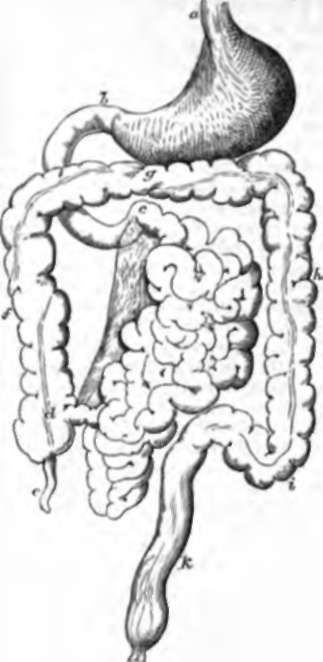60. The Lower End Of The Aesophagus
Description
This section is from the book "Animal Physiology: The Structure And Functions Of The Human Body", by John Cleland. Also available from Amazon: Animal Physiology, the Structure and Functions of the Human Body.
60. The Lower End Of The Aesophagus
The Lower End Of The Aesophagus, a little to the left of the middle line, pierces the diaphragm, as the arched muscular partition is called which separates the thoracic from the abdominal cavity, and it immediately terminates in the stomach.
The Stomach is a large expansion of the alimentary tube, which lies in great part under cover of the lower ribs of the left side, but extends across the middle line. It is of curved form, its upper surface being short and concave, its lower long and convex. At its left end, called also the cardiac extremity, it is expanded, and it gradually becomes narrower as the intestinal extremity is approached, a little to the right of the middle line. The entrance into the intestine is called the pylorus, and is guarded by a strong band of circular fibres, which keeps the opening usually closed, and gives to it the title of pyloric valve. Observations were made by watching the movements of the stem of a thermometer, the bulb of which was introduced into the stomach of a man, through a fistulous opening which had been left in the healing of a wound made by the accidental explosion of a gun; and it appears from them that when the stomach is acting, the contraction of its walls causes its contents to be moved about in a stream passing from left to right along the great curvature of the stomach, and back along the small curvature. While the stomach thus keeps its contents in motion, its walls rapidly absorb superfluous fluid, and at the same time pour out the gastric juice. By united mechanical and chemical action the food is gradually converted into pulp; and the pyloric valve, which, at the commencement of digestion, is kept quite closed, relaxes sufficiently to allow the pulp to pass as rapidly as formed, thus allowing the whole action of the stomach to be concentrated on the parts of its contents which are not yet broken down. Gradually, however, in the later stages of digestion, the irritability of the pyloric valve becomes exhausted, and at last even the most indigestible solids are allowed to pass.
They are the prominences corresponding to the edges of two muscles, the palato-pharyngei.

Fig. 60. Digestive Tube. a, AEsophagus ending in the stomach; b, pylorus; from 6 to c, duodenum; from c to d, jejunum and ileum with the line of attachment of the mesentery; d, caecum; e, vermiform appen-f, g, h, ascending, transverse, and descending colon; i, sigmoid flexure; k, rectum.
Continue to:
